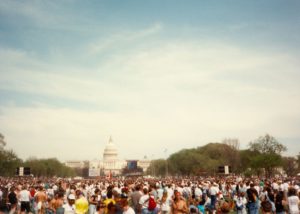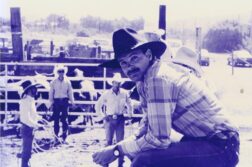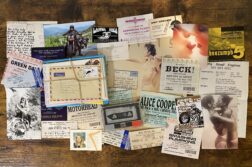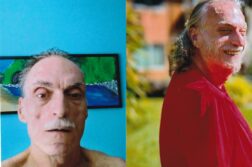
At the LGBT March on Washington on April 25, 1993, Ben and I walked with our friends south on Ninth Street to the National Mall. We spread out picnic blankets half-way between the U.S. Capital and the Washington Monument, joining what would become over one million protestors. I’d been a reluctant witness to much of the evolution of gay rights. I’d seen and experienced things, good and bad. After decades of baby-steps, I was finally out everywhere except at work and was living a comfortable status quo. Despite the energy of the crowd, I felt sad and ashamed, a failure for still being in the closet at work.
I’d spent the last eleven years constructing a careful out life within the constraints I’d been given. The price of being a sheltered, private-school kid in the 1970s was that you trusted and believed the uniform societal norms that insulated you from the larger world. Homophobia was rampant and encouraged. Despite crushes on boys, the occasional girlfriend kept me “safe” and on-track. I had a script to live. At Duke University, I joined a fraternity instead of exploring what it meant to be gay, in part because the new Gay and Lesbian Union office door was never open. My fraternity brothers knew I was a physics major and granted me occasional eccentricities.
After graduation in 1980, I landed a job at Westinghouse Defense and Electronic Systems Center during the worst job market since the Great Depression. I worked in integrated circuit fabrication, which required a security clearance. Like my fraternity, the security clearance world forbade granting membership to homosexuals. And in my line of work, if you didn’t have a clearance, you didn’t have a job. I felt lucky, then guilty the following year when I stopped lying to myself and realized I had no choice: I was gay. However, in a southern family you learn at a young age to live with guilt and a conflicting self-images, so I had a leg up.
Flying to and from Silicon Valley for work allowed me to get back in touch with an old friend who had moved to Milwaukee. Lisa and I had been in ninth and tenth grades together in Maryland. We’d briefly dated before her family moved; I took her to her senior prom, during which she came out to me. That was why we got along so well. We both vanished into college and finally reconnected during layover weekends as I flew between the coasts. In the fall of 1981, she and her lover moved to Maryland and we rented a house together. I had community and a support group.
I came out to my parents expecting to be disowned and was surprised that they didn’t kick me out of the family. By then I was a fully-fledged and self-sufficient adult. Soon after, in May 1982, Gay-Related Immune Deficiency—what AIDS was initially called—crashed the party, just as I was getting comfortable. It terrified me and I withdrew. I went from DC Pride parades in ‘81 and ‘82 to the AIDS Candlelight Vigil in 1983.
Getting healthy and looking healthy was important. I’d always been a runner and wanted to run a marathon when I turned thirty, so I quit smoking on my 29th birthday and started training for the Marine Corps Marathon. I got hooked and became a triathlete. Training gave me the perfect excuse not to socialize with coworkers and not to go to bars. I joined the gay swim team, DC/AC, and we volunteered to stay up all night guarding the AIDS Quilt in October 1987, the eve of another LGBT protest march.
In the nervous darkness, we walked the perimeter of the oval-shaped Ellipse in pairs, Reagan’s White House guarded and uncaring in the background. The hand-made memorial panels for AIDS victims, folded under protective waterproof tarps, formed dark mounds in a precise grid covering the entire park. There were midnight threats, shivers, walky-talkies, and lots of strong coffee. In the crisp morning light, other volunteers came and unfolded the vibrant panels in reverent silence as a new day dawned.
The next October, I met Ben in a popular video bar in DC called Badlands. I saw him across the sea of mingling men and wished I had the guts to go say hello. Ben’s friend noticed and shoved us together. “This guy’s been watching you all night,” his friend said. “Put him out of his misery.”

Ben and I couldn’t stop talking that night. Two years later we were living together. My coworkers thought I had a new roommate, but the secretaries knew better. “Ben is on line three,” they said, and I could hear smiles in their voice.
My bosses started telling me stories about how their wives had gay hairdressers or how they took dancing lessons from a limp-wristed instructor on the weekends. The nice ones were making an attempt to be friendly, however cryptic or obtuse. Others were overtly hostile. I remained politely uncomfortable and semi-invisible. The government still forbade granting security clearances to homosexuals. I didn’t have the guts to push anything, so I soldiered on and wondered about friendlier workplaces. Corporations were starting to market to gay people. Even better, tech companies were considering domestic partner benefits as a tool to lure or retain talent. I hoped that tolerance might be giving way to acceptance in places.
Then, on March 6, 1993, a personal setback: my mother married my stepfather. She told me she was afraid to tell him I was gay for fear he’d back out. I’d been with my partner for five years at that point, and out to my mother for eleven years. Ben was not invited to the wedding. To make sure I went, she put me in the ceremony. I was miserable, but I held it together until they cut the cake, and then I said my goodbyes. My new Irish-Catholic stepsiblings asked why I was leaving. After all, we’d had fun times together over the past year and this was a time to celebrate. I told them, “I’m going home to Ben, my partner. He wasn’t invited.”
To their credit, my five stepsiblings brought their spouses and kids down to our home in Greenbelt to apologize and welcome Ben into the new family. (Our parents weren’t invited.) I realized I couldn’t change my side of the family, but the new side could outnumber them. I was finally out to everyone, except at work.
Back at the National Mall the organizers set up giant screens called jumbotrons around the perimeter so everyone could see the staged events. Melissa Etheridge, RuPaul, and Madonna headlined. All around us, people came closer, and not only in proximity but in spirit, comradery, and purpose. We were there to demand rights, to get funding for AIDS research, and to remind Bill Clinton of his campaign promises. We were there to have fun and be together and be visible to the entire country.
We stripped off our tee-shirts, danced together in the sunlight, drank from our canteens, and shared suntan lotion. With so many of us on the Mall already and more marching in, it was a carnival—I got choked up at everyone smiling and hugging. The optimism and excitement rippled through us all. They had to notice a force this strong, right? At that moment I felt accepted, energized and, most importantly, resilient. I wanted to stay that way for the rest of my life. It was clear what I had to do.
The next day, April 26, 1993, I handed in my resignation to Westinghouse Defense and Electronic Systems. I’ve been out and happy ever since.
After the 1993 March on Washington, Bob Angell got his MBA at the R. H. Smith School of Business, worked toward an MFA at American University, and finished out his career path as an IT Business consultant. He is now a full-time writer and has just completed a collection of linked short stories about growing up gay in the last century. Several stories have been published over the years and you can find them at rrangell.com. Bob and his husband have been together for 32 years and counting. They live in Maryland and are between cats.







Discussion1 Comment
Such a great story and life’s work my friend. It’s an honor to be a brother with you! Love ya man!